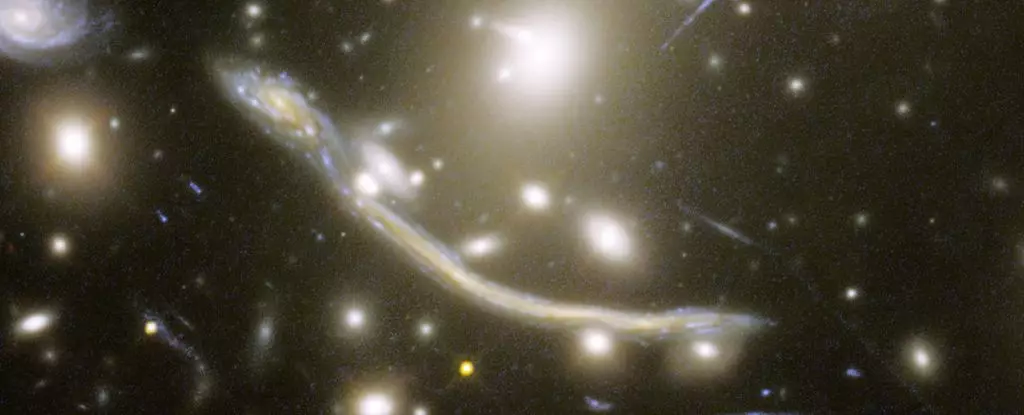The Universe is a vast expanse that often challenges our perception of reality. With distances measured in light-years and timelines reaching billions of years into the past, our capacity to observe distant celestial bodies has always been constrained. Despite these limitations, advancements in astronomy continue to push the boundaries of our observational capabilities. The James Webb Space Telescope (JWST) has emerged as a game-changer in this arena, allowing scientists to peer deeper into the cosmos and discover previously unseen stars in distant galaxies.
The Dawn of a New Observational Era
A recent milestone achieved by the JWST marks an exciting leap in our understanding of star formation and composition in the early Universe. Utilizing its sophisticated technology, astronomers were able to identify more than 40 individual stars located on the periphery of a galaxy whose light took approximately 6.5 billion years to reach Earth. “This groundbreaking discovery demonstrates, for the first time, the feasibility of observing a significant number of individual stars in a remote galaxy,” explains astrophysicist Fengwu Sun from the University of Arizona. The ability to analyze a larger population of stars is crucial; it enables researchers to glean insights into phenomena such as dark matter, which has been historically elusive.
The Role of Gravitational Lensing
The JWST’s success in uncovering these stars is intricately tied to the phenomenon of gravitational lensing. This effect occurs when high-mass celestial objects, such as clusters of galaxies, warp the space-time surrounding them—akin to a heavy object distorting a trampoline surface. The light emitted by objects situated behind these massive bodies becomes magnified and distorted, allowing astronomers to glean information about otherwise hidden celestial objects. One striking example is the Dragon Arc, a spectacular light formation that resembles a dragon, resulting from the gravitational warping caused by the Abell 370 galaxy cluster.
Astronomers utilize these gravitational lensing effects not only to study distant galaxies but also to reverse-engineer the distorted light to reveal the true nature of the objects residing beyond them. This advanced method of observation, coupled with JWST’s capabilities, has illuminated stars that were previously too faint and distant to detect. The combination of gravitational lensing and JWST’s sensitivity to infrared light allows for a new level of detail in cosmic observations.
The recent study led by Yoshinobu Fudamoto from Chiba University showcases a remarkable achievement in stellar observation. Initially aimed at identifying background light from distant galaxies, researchers stumbled upon an unexpected treasure: 44 individual stars nestled within the warped light of the Dragon Arc. This finding not only underscores the JWST’s innovative observational power but also raises important questions about stellar characteristics in the early Universe. The stars identified in the Dragon Arc predominantly consist of red supergiants—massive stars at the end of their life cycles, characterized by a cooler and redder appearance compared to the typically observed blue and white stars.
The predominance of red supergiants among these distant stars offers intriguing insights into the evolutionary history of galaxies. These stars usually elude detection due to their cooler temperatures, creating obstacles for other telescopes that favor bright and hot stellar emissions. However, the JWST’s advanced ability to observe infrared light allows astronomers to detect these cooler objects from billions of light-years away.
Looking ahead, the implications of these groundbreaking discoveries extend beyond the mere identification of stars in the universe. By accumulating data from numerous individual stars in the Dragon Arc, researchers will enhance their understanding of galactic evolution and stellar lifecycle dynamics in the early Universe. The ability to analyze a larger sample of stars will not only refine existing models of cosmic phenomena but also uncover new information about the role of dark matter in galaxy formation and evolution.
With continued observations and studies, the JWST is poised to reveal even more hidden treasures within the mosaics of distant galaxies. Each new discovery in this cosmic expanse provides a piece of the puzzle, helping humanity unlock the mysteries of the Universe.
As telescopes like the JWST breach the boundaries of our observational capabilities, we enter an era rich with opportunities for exploration and understanding. The recent identification of individual stars in the Dragon Arc is just the tip of the iceberg, paving the way for an enriched comprehension of galactic formation and the complex tapestry of cosmic histories. Indeed, the dark corners of the Universe are slowly illuminating, revealing the intricate dance of light and matter nestled within the cosmic shadows.

